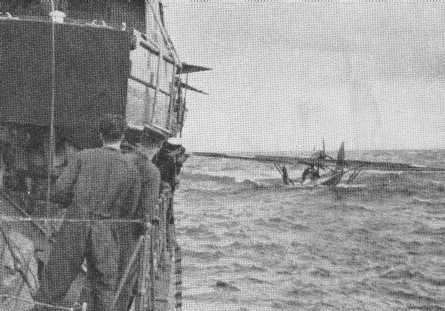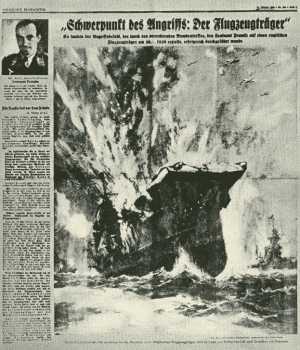Dinger's Aviation Pages
First Blood
Detailing the first confirmed victory by a British naval aircraft in WW2.
Detailing the first confirmed victory by a British naval aircraft in WW2.
After the loss of two Blackburn Skuas in the Fanad Head action, 803 Squadron were not long in getting revenge. On the 26th September, the Ark Royal along with the battleships Nelson and Rodney were part of a force sent to cover the escape of the badly damaged British submarine HMS Spearfish from German waters. They were 250 miles North West of the German North Sea fortress island of Heligoland when a Dornier 18 flying boat was sighted and at 11:00 hrs three Skuas of 803 Squadron were launched to intercept it. They claimed this Dornier as damaged near position 57.36N 02.36E. Another Dornier was sighted soon afterwards and another three Skuas of 803 were launched at 11:30 hrs. This Dornier was shot down by Lt BS McEwen and PO BM Seymour, the 4 crewmen of the stricken aircraft were picked up by the destroyer HMS Somali. A third Dornier then appeared and another three Skuas, this time of 800 Squadron, were launched at 12:30 and they claimed this third Dornier as damaged. One Dornier crashed in Dutch coastal waters during this period and it is possible this was one of the aircraft driven off by the Skuas.
The incident highlighted a critical deficiency in the radio equipment of the Skua. Although the German floatplanes were visible to lookouts on the warships their position could not be relayed with sufficient accuracy to the Skuas using Morse code (the Skua's radios could not transmit or receive speech). The Skuas had to be alerted to the direction of the German aircraft by flares launched by the warships.
The shooting down of the Dornier 18 is often cited as the first kill by a British Aircraft in World War II. In fact the first was by Sgt F.A. Letchford, an observer/gunner in a Fairy Battle Bomber of 88 Sqdn RAF, 6 days earlier, on the 20th September 1939. Sgt Letchford's claim was not confirmed straight away. See notes below for the full story.

This is the actual Dornier 18 shot down by the Skuas. The Dornier's crew are scrambling into an inflatable dingy prior to being rescued by the destroyer HMS Somali. the Dornier was then sunk by Gunfire from the destroyer. At one stage there was a suggestion that these photos, and others in the same sequence, were of a Dornier shot down on 17th October 1939 by Gladiators of 607 Squadron, the crew being rescued by HMS Juno. This possibility has been ruled out by research by Robert Dixon.

The Dornier seen from HMS Somali as it closed to pick up the crew. The Dornier was then sunk by naval gunfire
With the position of the British fleet passed to the Luftwaffe by the Dornier 18 flying boats, a force of German bombers was soon on its way. At the time this force was reported by the British to be Heinkel He 111s, but the aircraft that actually attacked the Ark Royal were Junkers 88s*. Bad visibility obstructed the bombers attacks. No Skuas were airborne to intercept them, Royal Navy doctrine at the time was that bomber attacks could be driven off by anti-aircraft fire alone! A policy soon to change! None of the German bombers scored any hits, but a very close miss was scored by Leutnant Adolf Francke flying one of the Ju 88s who reported that he thought he had hit the Ark Royal. A reconnaissance flight by the Germans later spotted a large fleet of Royal Navy ships without an aircraft carrier amongst them so the Germans assumed that the Ark Royal had been sunk. What they did not know was that there had been two large groups of Royal Navy ships in that part of the North Sea that day, and they had spotted the one without an aircraft carrier. Poor Adolf Francke was caught up in the Nazi propaganda machine, he was hailed as a hero, promoted and given the Iron Cross while the Nazis churned out vivid accounts of his destruction of the Ark Royal. This all backfired when the Royal Navy was able to show off the Ark Royal in neutral ports. Adolf Francke later reportedly committed suicide (although this is disputed). The lesson of trying to score a hasty propaganda coup was not lost on the British, but it did mean they did not take full propaganda advantage of the Skuas sinking of the cruiser Königsberg a few months later.

The German press revelled in the "sinking" of the Ark Royal.
From October 1939, 801 Squadron operated briefly from HMS Furious on Convoy Patrols. 803 Squadron stayed aboard the Ark Royal when she was sent to operate from Freetown on the West Coast of Africa as part of "Force K" searching for the German pocket battleship Graf Spee. When this threat was removed by the scuttling of the Graf Spee at Montevideo on 17th December 1939 the Ark Royal returned to Scapa Flow. The two Skua squadrons then operated as fighters for the defence of the fleet anchorage at Scapa Flow operating out of the RAF airfield at Wick on the Scottish mainland and Hatston airfield, just west of Kirkwall in the Orkney Islands (known as HMS Sparrowhawk by the Navy). During the winter and spring of 1940, the Skuas drove off many Heinkels and Dorniers, but only one kill was claimed, on 20th March, a Heinkel 111 was destroyed by Lt.William Paulet Lucy (commander of 803 Squadron) and his crewman Lt. Michael Charles Edward Hanson. In this period some Blackburn Rocs were also operated by the Hatston squadrons and one of these, operated by 803 Squadron claimed a Heinkel 111 damaged. The Squadrons were operating a mix of Skuas and Rocs in this period, and the extra range of the Skua was considered of great benefit compared with the shorter range of RAF Fighters such as the Spitfire and Hurricane. The Skua squadrons then went on to sink the German cruiser Königsberg in Bergen harbour and take part in the Norwegian campaign.
Note
* It is hardly surprising that the British misidentified the Ju88s as Heinkels because they would never have seen any pictures of this new German design (the first image of a Ju88 to appear in "Flight" magazine did not do so until the 12th October 1939, even then it was an inaccurate artists impression rather than an actual photo). Confirmation that the aircraft that attacked the Ark Royal were in fact Ju 88s can be found in Henry Buckton's book "Birth of the Few" (Airlife 1998 ISBN 1 85310972 X). On Page 66 there is a quote from Sigmund Storp who flew in a Ju 88 alongside that flown by Adolf Francke.
Notes on the first British aircraft to shoot down an enemy aircraft in WWII.
On 20th September 1939, three Fairey Battle bombers of 88 Squadron based at Mourmelon-Le-Grand in France as part of the RAF Advanced Air Striking Force (A.A.S.F.) took off at 10 am for a recce flight along the length of the German border from east of Saarbrücken all the way to Aachen. The aircraft were fired on by French anti-aircraft guns before they crossed the border near Bitche (the firing ceased when the aircraft fired off "colours-of-the-day" flares). Over Aachen, they were engaged by three Messerschmitt Bf109 fighters. Battle K9245 flown by Flight Sgt D.A. Page with crewmen Sgt A.W. Eggington and AC1 W.A.W. Radford was shot down, quickly followed by Battle K9242 flown by Flying Officer R.C. Graveley with crewmen Sgt W.S. Everett and AC1 D.J. John. Flying Officer Graveley was awarded the Empire Gallantry Medal (later exchanged for the George Cross when it was introduced) for his attempts to rescue his crew from the burning aircraft. In the remaining aircraft, K9243 flown by Flying Officer L.H. Baker and crewed by Sgt L.H. Letchford and AC1 C.A. Edwards, fire was returned by Sgt L.H. Letchford in the gunner's position. He claimed a Bf109 shot down. This does not seem to have been officially "confirmed" at first, which is why the shooting down of the Dornier by Skuas on the 26th is often listed as the first British aerial victory of WWII. It should more accurately be called the first British aerial victory to be confirmed. Evidence to support the claim for Sgt Letchford came later, from French sources, which in turn led to it being confirmed. However German records list no Bf109 being lost in combat on the Western Front that day.
